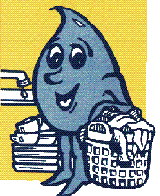|
Water-Wise Tips for Kitchens and Laundry
A PDF version of this publication is also available. (633 Kb) Cooking and cleaning shouldn't make wasteBy making a few small changes to your cooking and cleaning habits in the kitchen and laundry areas, you can drastically reduce the amount of water you use without cramping your lifestyle. Give your dishes a quick rinse – not a shower!
If you have an automatic dishwasher, use it only to wash full loads, and use the energy saver or shortest cycle. Clean and cook food the wise wayWhen cleaning fruits and vegetables, never let the tap run continuously. Instead, wash them in a partially filled sink, then rinse them quickly under the tap. When boiling vegetables, use only enough water to cover them, and use a tight-fitting lid. Steaming uses even less water while conserving more nutrients. The coldest drinking water comes from the refrigerator
Water should be the only thing that goes down your drainNever put garbage of any kind down the sink drain. Cooking fat and greases, household cleaners, paints, solvents, pesticides and other chemicals can be very harmful to the environment and your piping system. Reduce water flow from your tapsInstall an aerator attachment on your sink faucets and reduce water use by 25-50% (see pamphlet entitled "Water-Saving Devices"). Don't let your clothes get lonely in the laundry
Use only cleaning products that will not harm the environment. Buy phosphate-free biodegradable detergents. One small leak can waste thousands of litres of water!Regularly check faucets, pipes, taps, hoses and the fittings of your washing machine for leaks and repair immediately. Leaks waste water 24 hours a day, seven days a week and can often be repaired by replacing a washer, which costs only a few cents. Always turn your taps off tightly but gently so they don't drip. REMEMBER, the WISE USE OF WATER will save you money and help improve the environment. 
An environmental citizen uses water wisely |
|
|
||||||||||||
|
| Help
| Search
| Canada Site |
|
||
|
The Green LaneTM, Environment Canada's World Wide Web site
|
||
|
|
||
|
|
||